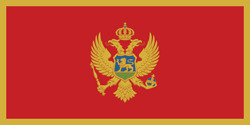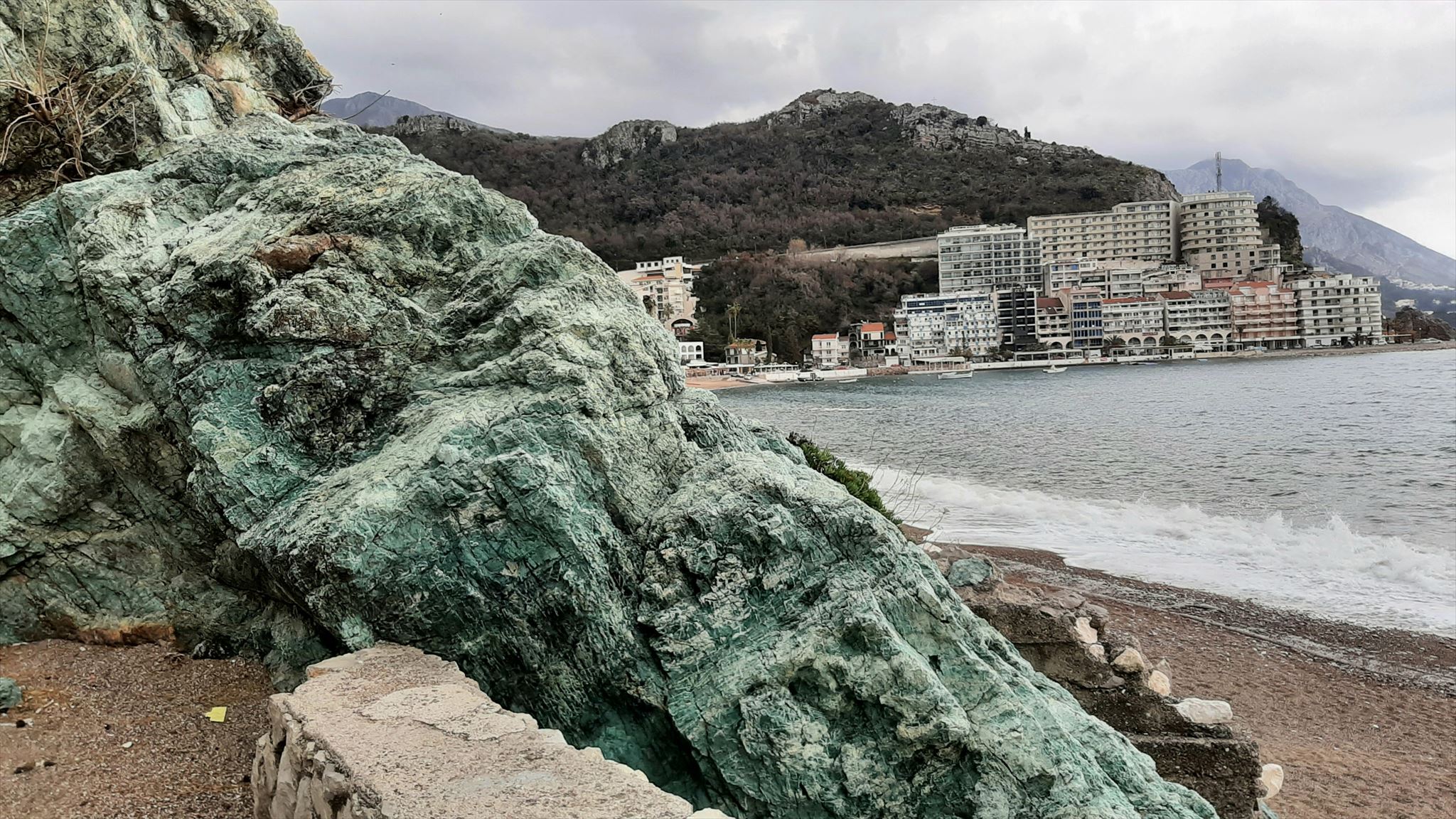
Pored posebno lijepo nabranih sedimentnih stijena, na plaži Rafailovići postoji i znatno manja grupa stijena. Ima impresivnu zelenu nijansu i izgleda veoma različito od okolnih stijena. Nedostatak slojevitosti i mnoge bijele žile koje prolaze kroz stijene ukazuju na to da se ne radi o sedimentnim stijenama, već da su ove stijene nastale na drugačiji način.


Ako bolje pogledate stijene, postoji mnogo dokaza da je stijena serpentinit.
Naziv serpentinit dolazi od latinske riječi serpens, što znači "zmija". Razlog tome je često karakterističan, zmijski crtež minerala. Ultrabazična stijena se sastoji uglavnom od serpentinskih minerala, na primjer lizardita, hizotila, antigorita, brindliita i pekoraita.
Serpentinit je tamnozelen, svijetlo zelen, ponekad žućkast, smeđi do crvenkast i često prošaran svijetlim žilama kalcita. Sadržani hematit uzrokuje crvenu boju.
Formiranje serpentinita
To se dešava unutar zemlje: jak pritisak i visoke temperature osiguravaju da komponente stijene, minerali, reaguju jedni s drugima i transformiraju se. Tako nastaje nova stijena. Budući da je grčka riječ za transformaciju "metamorfoza", geolozi također govore o metamorfnim stijenama. Serpentinit je jedna takva metamorfna stijena.
Serpentin nastaje tercijarno, a karakteriše ga činjenica da se kamen iznutra transformiše hemijskim reakcijama. Ovaj proces se naziva serpentinizacija. Serpentiniti su stoga metamorfne stijene, koje nastaju pod određenim uvjetima pritiska i temperature (300 do 500 °C) uglavnom transformacijom takozvanih peridotita. To se posebno dešava u procesima formiranja planina. Serpentinit također nastaje serpentinizacijom stijena bogatih olivinom. Serpentinizacija počinje unutar mikroskopskih pukotina u zrnima olivina matične stijene i formiraju se tanke serpentinske membrane krizotilnih vlakana. Matične stijene se restrukturiraju uz sudjelovanje hidrotermalnih otopina, što rezultira transformacijom u serpentine.
Stene u zemljinoj unutrašnjosti doživljavaju lomove i pomeranja, što rezultira pukotinama, pukotinama i ponorima, u koje prodire topla duboka podzemna voda ili magma. Ovaj proces se u geologiji naziva intruzija. Punjenje vena stvara vruća voda, koja oslobađa minerale iz stijene na zidovima pukotina. Nakon hlađenja i kristalizacije stijena je ukrašena žilama.
Serpentinizacija vezuje velike količine vode (uglavnom u mineralima serpentina) u stijeni, a vjeruje se da ovaj proces igra važnu ulogu u Zemljinom hidrološkom ciklusu.
Pojava serpentinita
U osnovi, može se reći da se serpentiniti javljaju na površini zemlje u područjima sa jakim tektonskim uticajima sa srednjim do visokim stepenom metamorfizma i podignuti su sa većih dubina. Iz tog razloga, oni se nalaze samo u relativno malim razmjerima i imaju samo ograničeni opseg u poređenju sa sedimentnim stijenama. Oni su dio okeanske kore u srednjeokeanskim grebenima i rubovima ploča. Tipična mjesta za serpentinite su rubovi kontinentalnih ploča, prelomne zone i planine nabora.
Pažljivo pogledajte male zelene stijene i odgovorite na sljedeća pitanja prije sječe!
1. Da li je kamen ujednačeno zelene boje ili možete vidjeti varijacije boja?
2. Možete li svugdje ili na nekim mjestima pronaći oznake u obliku zmija na stijenama?
3. Šta mislite da je otpornije na vremenske prilike, sama stijena ili bijele žile koje prolaze kroz nju? Opravdajte svoju pretpostavku!
4. Pogledajte šljunak na plaži pored stijena. Da li i ovdje nalazite više zelenih kamenčića?
5. Uslikajte sebe ili lični predmet u Green Rocks-u i zakačite ga na svoj dnevnik!
Pošaljite mi e-mail sa svojim odgovorima! Možete se prijaviti odmah nakon slanja odgovora. Ako nešto nije u redu, javiću vam. Ne morate čekati na objavljivanje dnevnika! Nadam se da ćete uživati u ovom geološkom putovanju otkrića!

Apart from the particularly beautifully folded sedimentary rocks, a much smaller group of rocks also stands out on Rafailovići beach. It has an impressive green colouring and looks quite different from the surrounding rocks. The lack of layering and the many white veins running through the rock indicate that this is not a sedimentary rock, but that these rocks were formed in a different way.


If you take a closer look at the rocks, there is a lot to suggest that it is the rock serpentinite.
The name serpentinite comes from the Latin word serpens and means "snake". The reason for this is the often characteristic, snake-like pattern of the mineral. Mainly the ultrabasic rock consists of serpentine minerals, for example lizardite, chysotile, antigorite, brindleyite and pecoraite.
Serpentinite is dark green, variegated green, sometimes yellowish, brown to reddish and often reticulated with light calcite veins. Contained haematite causes a red colouration.
The formation of serpentinite
It happens inside the earth: strong pressure and high temperatures cause the components of the rock, the minerals, to react with each other and transform. In this way, new rock is formed. Because the Greek word for transformation is "metamorphosis", geologists also speak of metamorphic rocks. Serpentinite is such a metamorphic rock.
Serpentinite is formed tertiary, which is characterised by the fact that the stone transforms internally through chemical reactions. This process is called serpentinisation. Serpentinites are therefore metamorphic rocks, which form under certain pressure and temperature conditions (300 to 500 °C) mainly from the transformation of so-called peridotites. This happens in particular during mountain-forming processes. Serpentinite is also formed by serpentinisation of olivine-rich rocks. Serpentinisation begins within microscopic cracks in the olivine grains of the source rock and thin serpentine skins of chrysotile fibres are formed. The source rocks are restructured in the process with the involvement of hydrothermal solutions, resulting in the transformation to serpentine.
The rocks in the Earth's interior experience fractures and displacements, creating cracks, fissures and fissures into which hot deep groundwater or magma penetrates. This process is called intrusion in geology. The vein fillings are caused by hot water, which dissolves minerals from the rock on the fissure walls. After cooling and crystallisation, the rock is decorated with veins.
During serpentinisation, large amounts of water (mainly in the serpentine minerals) are bound in the rock, and this process is thought to play a significant role in the Earth's water cycle.
Occurrence of serpentinite
Basically, it can be said that serpentinites occur on the earth's surface in areas of strong tectonic action with medium to high degrees of metamorphism and have been uplifted from greater depths. For this reason, they are only found on a relatively small scale and have a limited extent compared to sedimentary rocks. They are part of the oceanic crust in the mid-ocean ridges and plate margins. Typical places for serpentinites are therefore the margins of continental plates, fracture zones and fold mountains.
Look closely at the small green rocks and then answer the following questions before logging!
1. Is the rock uniformly green in colour or can you recognise colour variations?
2. Can you find the snake-like pattern of the rock everywhere or in some places?
3. Which do you think is more weather-resistant, the rock itself or the white veins that run through it? Give reasons for your assumption!
4. Look at the pebbles on the beach next to the rocks. Do you find more green pebbles here too?
5. Take a photo of yourself or a personal object at the Green Rocks and hang it on your log!
Send me an email with your answers! After sending your answers, you can start logging right away. If something is wrong, I will contact you. You don't have to wait for the log to be released! Have fun on this geological journey of discovery!

Außer den besonders schön gefalteten Sedimentgesteinen fällt am Strand von Rafailovići auch eine deutlich kleinere Felsengruppe auf. Sie hat eine beeindruckende grüne Färbung und sieht ganz anders aus als die umliegenden Felsen. Die fehlende Schichtung und die vielen weißen Adern, die das Gestein durchziehen, deuten darauf hin, dass es sich hier nicht um ein Sedimentgestein handelt, sondern dass diese Felsen auf eine andere Art entstanden sind.


Schaut man sich die Felsen genauer an, deutet sehr viel darauf hin, dass es sich um das Gestein Serpentinit handelt.
Der Name Serpentinit stammt aus dem lateinischen Wort serpens und bedeutet "Schlange". Der Grund hierfür ist die häufig charakteristische, schlangenähnliche Zeichnung des Minerals. Hauptsächlich besteht das ultrabasische Gestein aus Serpentinmineralen, zum Beispiel Lizardit, Chysotil, Antigorit, Brindleyit und Pecorait.
Serpentinit ist dunkelgrün, buntgrün, manchmal auch gelblich, braun bis rötlich und oft mit hellen Calcitadern netzartig durchsetzt. Enthaltenes Hämatit verursacht eine Rotfärbung.
Die Entstehung von Serpentinit
Es geschieht im Inneren der Erde: Starker Druck und hohe Temperaturen sorgen dafür, dass die Bestandteile des Gesteins, die Minerale, miteinander reagieren und sich verwandeln. Auf diese Weise bildet sich neues Gestein. Weil das griechische Wort für Verwandlung „Metamorphose“ lautet, sprechen Geologen auch von metamorphen Gesteinen. Serpentinit ist ein solches metamorphes Gestein.
Der Serpentin entsteht tertiär, was sich dadurch auszeichnet, das sich der Stein durch chemische Reaktionen innerlich umwandelt. Dieser Vorgang wird als Serpentinisierung bezeichnet. Serpentinite sind demzufolge metamorphe Gesteine, welche sich unter bestimmten Druck- und Temperaturverhältnissen (300 bis 500 °C) vorwiegend aus der Umwandlung von so genannten Peridotiten bilden. Dies geschieht insbesondere bei gebirgsbildenden Vorgängen. Serpentinit wird zudem durch eine Serpentinisierung von olivinreichen Gesteinen gebildet. Die Serpentinisierung beginnt innerhalb mikroskopisch kleiner Risse in den Olivinkörnern des Ausgangsgesteins und es bilden sich dünne Serpentinhäutchen aus Chrysotilfasern. Die Ausgangsgesteine werden dabei unter der Beteiligung von hydrothermalen Lösungen umstrukturiert, wodurch die Umwandlung in Serpentin erfolgt.
Die Gesteine im Erdinnern erleben Brüche und Verschiebungen, dabei entstehen Risse, Spalten und Klüfte, in welche heisses Tiefengrundwasser oder Magma eindringt. Dieser Vorgang wird in der Geologie Intrusion genannt. Die Aderfüllungen entstehen durch heisses Wasser, welches Minerale aus dem Gestein an den Spaltenwänden löst. Nach dem Auskühlen und Auskristallisieren ist des Gestein mit Adern dekoriert.
Bei der Serpentinisierung werden große Mengen an Wasser (hauptsächlich in den Serpentinmineralen) im Gestein gebunden, und es wird eine bedeutende Rolle dieses Prozesses für den Wasserkreislauf der Erde angenommen.
Vorkommen von Serpentinit
Grundsätzlich kann man sagen, dass Serpentinite an der Erdoberfläche in Bereichen mit starker tektonischer Einwirkungen mit mittel- bis hochgradigen Metamorphosegraden auftreten und aus größerer Tiefe emporgehoben wurden. Aus diesem Grund findet man sie nur relativ kleinräumig und sie haben im Vergleich zu Sedimentgesteinen eine nur begrenzte Ausdehnung. Sie sind Bestandteil der ozeanischen Kruste in den mittelozeanischen Rücken und Plattenrändern. Typische Orte für Serpentinite sind also die Ränder von Kontinentalplatten, Bruchzonen und Faltengebirge.
Schaut euch die kleinen grünen Felsen genau an und beantwortet dann vor dem Loggen folgende Fragen!
1. Ist das Gestein einheitlich grün in seiner Färbung oder könnt ihr Farbvarianten erkennen?
2. Findet ihr die schlangenähnliche Zeichnung des Gesteins überall oder an einigen Stellen?
3. Was glaubt ihr ist witterungsresistenter, das Gestein selbst oder die weißen Adern, die es durchziehen? Begründet eure Vermutung!
4. Schaut euch neben den Felsen die Kiesel am Strand an. Findet ihr auch hier vermehrt grüne Kieselsteine?
5. Macht ein Foto von euch oder einem persönlichen Gegenstand bei den Green Rocks und hängt es an euren Log!
Schickt eine Mail mit euren Antworten an mich! Nach dem Absenden der Antworten könnt ihr gleich loggen. Falls etwas nicht in Ordnung ist, melde ich mich. Ihr braucht nicht die Logfreigabe abwarten! Ich wünsche euch viel Spaß bei dieser geologischen Entdeckungsreise!

Quellen: wikipedia, wmk-natursteinhandel.de, mineralienatlas.de, strand-und-steine.de, geothermie.de